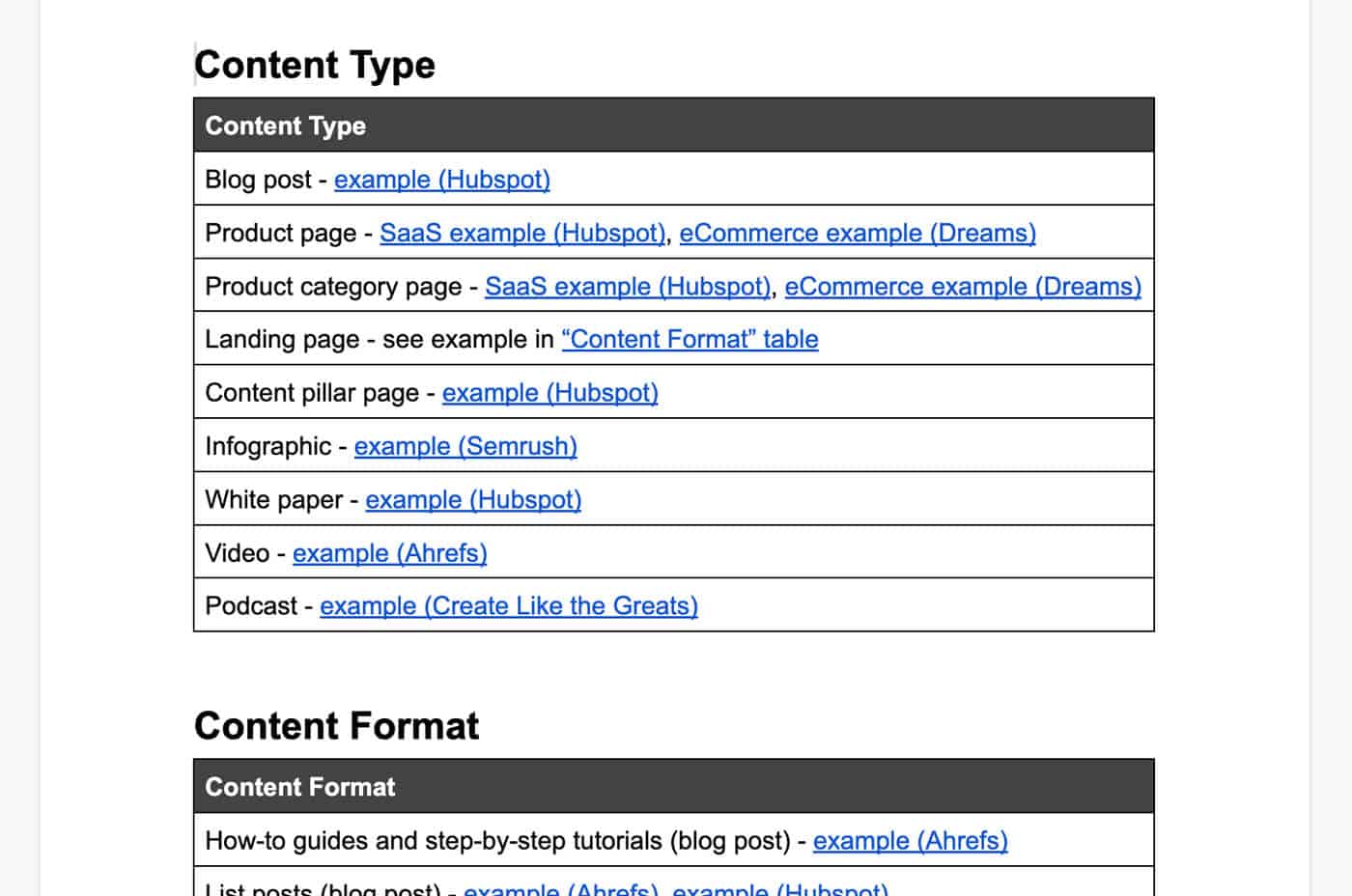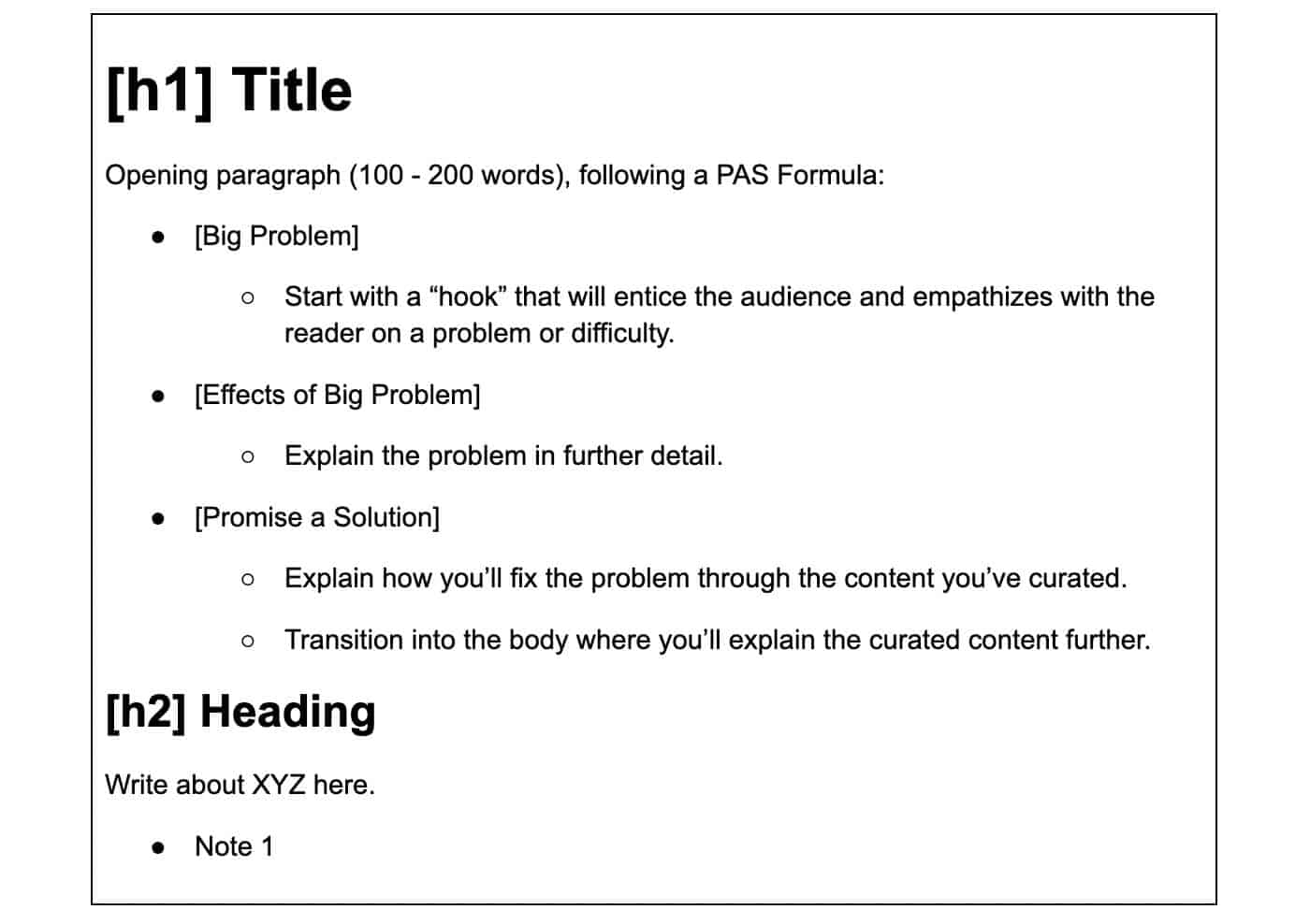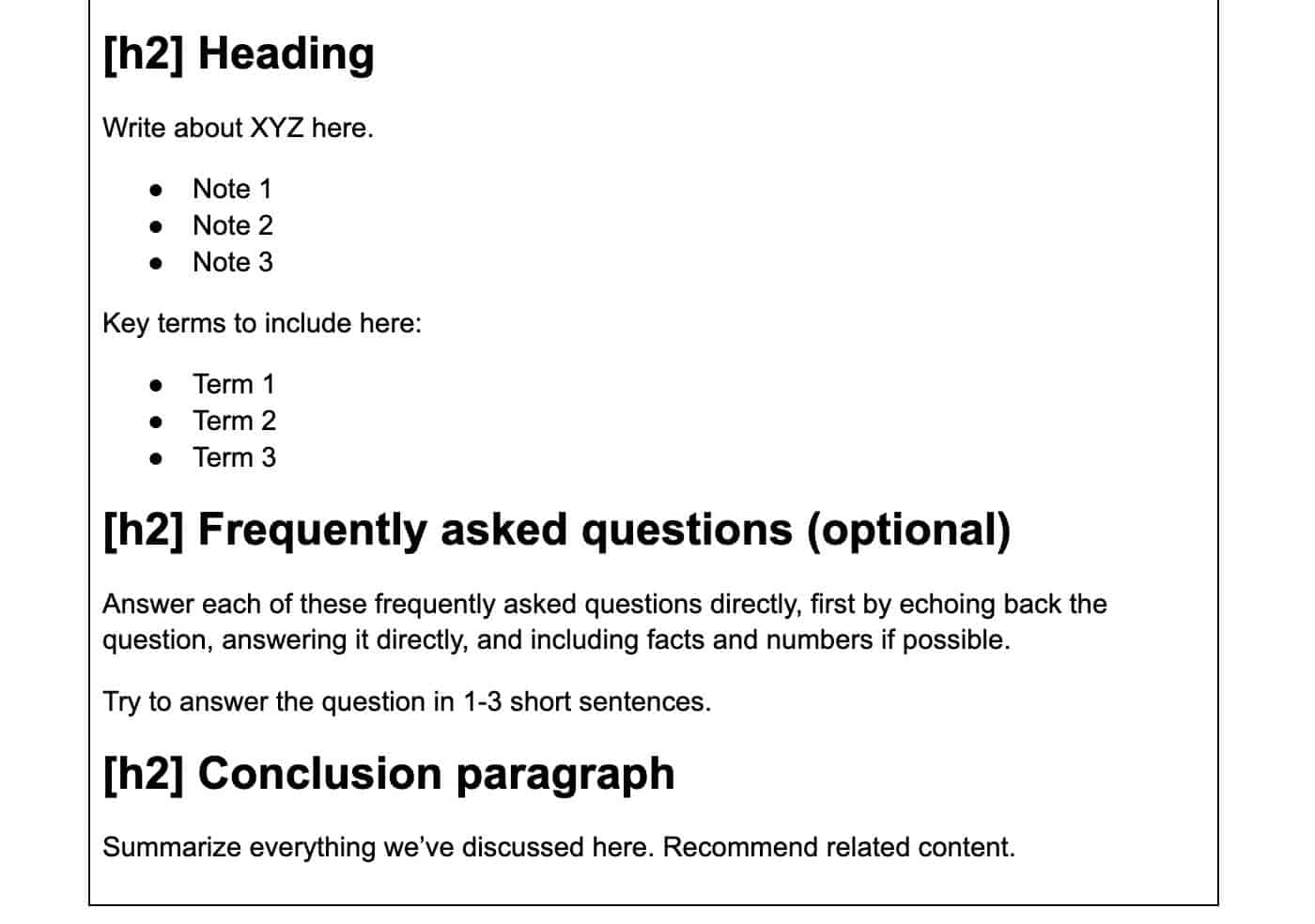Improve your content quality and save time with a proven Content Brief Template! Available in Word, Google Docs, and PDF formats.
This template allows you to create a content brief and outline that provides a comprehensive overview of the content piece to be created.
Using this template, you can improve the quality of your content, optimize it for SEO, streamline the process, and save time.
Download the Content Brief Template
Content Brief Template
Jump to other sections:
- Download the Content Brief Template
- What Is a Content Brief Template?
- Why Use a Content Brief Template?
- What Is Included in a Content Brief Template?
- How To Fill Out a Content Brief Template?
- Here Are Templates In Case You Didn’t Get Them Yet…
What Is a Content Brief Template?
A content brief template is a document used to create a content brief. It provides the framework and structure you need to create a comprehensive overview of the content piece. The content brief then serves as a guide for writers, editors, marketers, and other professionals involved in creating content.
An effective content brief template should include the sections for the description of the target audience, goal, CTA (call-to-action), SEO title and meta description, writing and brand guidelines, deadlines, and other elements.
It should also have space to outline the section headings and include notes about what should be included in each section of the content piece.
Why Use a Content Brief Template?
When it comes to creating content that is consistently optimized for search engines, attracts readers, provides helpful information, and meets editorial standards, a content brief template is an invaluable tool.
Here are the main reasons why you should use one:
Consistently Capture All the Important Information
A template helps you create a content brief with all the important information included and organized in a consistent manner.
The risk of forgetting an important detail is significantly reduced when all the information is
generated based on one template and compiled in one document.
This also helps to keep everyone on the same page. You always have a single document you can refer back to if need be, and the risk of miscommunication is also minimized.
Save Time Creating New Content Briefs
Once you have created a content brief template, creating subsequent content briefs becomes much faster and easier. So, instead of starting from scratch, you can easily fill out the template with the necessary details, and then use it as a skeleton for your content.
This way, you can quickly get up and running with new content projects and save time.
Reduce the Number of Revisions
A template helps you create a content brief that is comprehensive from the beginning.
Have you had times when you had to send a content piece back and forth to make sure all the essential elements are included?
It could be that due to a lack of clarity, it had to be revised multiple times.
As you outline all the important information upfront using a standardized template, you reduce the chances of going back and forth with revisions.
Faster Content Turnaround Time
Related to the reasons above, a template enables you to create content quickly and efficiently.
By having all the important information at hand and the structure of the document laid out, you, and/or your content writers, can focus on writing without having to worry about other elements.
This is especially useful if you’re working to tight deadlines and with larger teams.
As a result, you can make approvals faster and get content published quicker.
Streamline Your Content Marketing Process
You have probably heard it many times:
“Documented processes lead to better results.”
A content brief template helps you do just that.
By creating a document with all the relevant information and guidelines, you can more easily plan out individual content projects, effectively communicate with your team, and create content more efficiently.
Without a doubt, other documents such as an editorial calendar, content style guide, checklists, standard operating procedures (SOPs), and other templates, also help streamline and strengthen, your content marketing processes. And should be used accordingly to ensure more streamlined content marketing processes.
What Is Included in a Content Brief Template?
A content brief template that you can download here includes the following sections.
Deadlines
In this section, you can specify the date when the content is due, any revision deadlines, and any other important dates.
Specific subsections included in this section are:
- Draft due dates
- Publish date
Guidelines
Here, you can include any specific guidelines that must be followed during the content creation process.
The ones that are included in the template are:
- Writing guidelines
- Brand guidelines
- Tone of voice
Content Details
In this section, you can outline the objectives, goals, and all the possible details of the content project. Subsections included in this template are:
- Content topic
- Content type
- Content format
- Content angle
- Goal
- CTA (call-to-action)
- Target audience
- Search intent/customer journey
- SEO page title
- SEO meta description
- Preferred URL
- Primary keywords
- Secondary keywords
- Word count
- Content optimization report
- Internal links to
- Internal links from (after publishing)
- Sources
- Visuals
- Competitor examples
Content Outline
Lastly, you can include an outline of the overall content, suggested heading structure, and any notes about what should be included in each section.
The content in this section will vary the most depending on the purpose of the content, so a very basic structure is provided in the template. However, it should be adjusted and more specific sections should be added as needed:
- [h1] Title
- [h2] Heading
- [h2] Heading
- [h2] Heading
- [h2] Frequently asked questions (optional)
- [h2] Conclusion paragraph
How To Fill Out a Content Brief Template?
Here is a step-by-step mini-guide on how I would suggest filling out a content brief template.
1. Set Deadlines
This could be the first or one of the last steps you take when filling out the template.
Setting realistic deadlines will help you create a timeline for content creation, revisions, and publishing.
Fields for specific deadlines that are included in the template are the following.

Draft Due Date
This will be the date when the initial draft of the content should be completed.
Publish Date
This is the date when you plan the content to get published.
You can add more subsections for filling out other deadlines depending on your specific project needs and the editorial process you are following.
2. Specify Guidelines
With this section, you can feature any specific guidelines or rules that need to be followed when creating the content.

Writing Guidelines
These are the specific guidelines for writing, such as avoiding jargon, following a certain paragraph structure, and the like, that need to be applied in the content creation process.
I would suggest simply linking to your writing guideline document and leaving it out from the actual content brief.
Brand Guidelines
These are the rules around branding and will include things like the usage of colors, fonts and font sizes, logo placements, brand taglines, and other brand elements.
Although this might not be the most relevant during the text content creation process, this is a good reference mostly for visual content designers.
Again, I suggest you link to this document instead of including it in the content brief itself.
Tone of Voice
This is the specific tone of voice you want to use in your content.
It might be formal, informal, educational, etc.
There might be an overlap with the writing guidelines here, but I have found that it’s better to remind the people involved in the content creation process about this more directly.
3. Fill In Content Details
This is probably the most important part of a content brief template as it contains all the key details of the content project.
It has many subsections that you can fill in, so let’s break them down one by one.
Content Topic

First, you need to specify the topic of your content.
It could be just an overarching topic, like “B2B Marketing Strategies” or a more specific one, like “Twitter for B2B Marketing”.
This is just a broad overview of what the content will be about and will help the content writer stay focused on the general direction.
Content Type

You need to be clear about what type of content you want to be created, whether it’s a blog article, some sort of landing page, product category page, content pillar page, infographic, etc.
Here I have included some of the common ones, along with examples of each. This document is also linked to the downloadable content brief template, in the associated subsection.
So, be sure to check it out for some inspiration and ideas.

The best way you find out what type of content should be created is by doing a Google search for your topic and seeing what type of content appears on the SERPs (Search Engine Result Pages). This is a good indication of what type of content works best for the topic, and what users are looking for.
Content Format

The format of the content is also important, as it will determine how you want your content to be structured. This could mean whether it’s going to be a “how-to guide”, “list post”, or “expanded definition post” if we talk about blog articles. In regard to landing pages, it could be, for example, a “tool”, or a “calculator”.
Again, here is the same document with some of the common content formats.
Same as with content type, you can also research what format is best for the given topic by searching for it on Google and seeing how other websites have structured their content.
Content Angle

The angle of the content is related to both the type and format.
You will need to decide what angle are you going to take with this content. In other words, what is the unique perspective or selling point you are going to bring to the table?
For example, if you are writing a blog article about B2B marketing, you could take an angle that is targeted at complete beginners, or an angle that would be suitable for more experienced marketers – a deep dive into a niche topic.
Picking a specific angle will help make the content more focused, and give it an extra bit of flair.
Again the best place to start is Google search – look at what kind of content already exists for your topic, and see if you can add something better to the mix whilst not going too far away from the main topic.
NOTE
Sometimes, it might not be the best approach to follow a different angle. If the content you plan to create is about a very common, specific topic, where most search results follow a certain angle, then it might be better to stick with the basics and just create a more helpful version of what’s already out there.
Goal

In this section, you need to specify the goal of your content.
What is that you want to achieve with the content, and how will you measure its success?
For example, if it’s a list-based blog post about “the best content marketing tactics in 2023”, the goal could be to get readers to subscribe to your newsletter for more content marketing tips.
Or, imagine that you are selling a product and you want to create a “how-to guide” that shows how to solve a specific problem. The goal could be to get more readers to visit your product page(s) by showing them how the product can help them solve their problem as the most effective solution.
CTA (Call-to-Action)

Here, you can specify the call-to-action associated with your content.
This is the action you want your readers to take after they have read your content such as:
- Subscribing to a newsletter
- Downloading a resource
- Clicking on the links to explore related topics
- Viewing related products/services
You can also specify where exactly you want the CTA(s) to appear in the content, for example:
- At the top and/or bottom of the page
- In the sidebar
- In the body of the content
- Or, in a pop-up that appears when a user has been scrolling for a certain amount of time or a percentage of the page
Just make sure that your CTA is relevant to the content, and that it doesn’t come off as too aggressive or intrusive.
Target Audience

Who is it that you are trying to reach with your content?
And what are their needs, desires, and challenges that you need to address in order to make the content successful?
Write answers to these questions in this subsection.
But be careful not to go over the top and describe the full profile of the target audience.
The goal here is to get a general idea of who the content is aimed at so that you and/or your content writers can create content that will be relevant and valuable specifically to that audience.
Search Intent / Customer Journey

Describe the primary search intent that the content should address.
Search intent can be thought of as the motivations and goals of the people that are searching for content related to this topic, for example:
- Is the target audience looking for quick answers to specific questions?
- Are they looking to learn more about how to do something specific?
- Are they looking for a tool that would help them with a specific task? Like a content brief template for example.
- Are they looking to compare different options for a certain product/service?
The most common way of classifying the search intent is by identifying 4 main types:
- Informational (seeking information)
- Navigational (looking for a specific website/URL)
- Transactional (looking to buy something)
- Commercial (exploring options before making a purchase decision)
You can use these 4 types of intent as a starting point when determining the search intent associated with your content.
Then, you describe further how the content should address this intent.
NOTE
The search intent is also closely related to the content type, format, and angle that you choose for the content. So, make sure you keep that in mind when determining the search intent and vice versa.
SEO Title

Assuming that you are producing website content for the purpose of ranking in search engines, you need to specify the SEO title of the page for more optimal results.
The title should be optimized and, ideally, include the primary keyword, and be around 50-60 characters in length.
Make sure that this title is descriptive and relevant to the content, but also catchy so that it stands out from the competition on the search results page.
Curious to learn more about creating SEO-focused content briefs? Check out the full guide on SEO content briefs!
SEO Meta Description

You should also specify an SEO meta description for the page.
The meta description should be around 160 characters in length, include the primary keyword(s), and describe what the content is about so that people can decide whether they want to click on it or not.
It should also be catchy so that people are more likely to click on your content instead of the competition’s.
Preferred URL

Here, you can specify the preferred URL for the page.
It should be as short and descriptive as possible and ideally include the primary target keyword.
This brings me to the next subsection…
Primary Keywords

Specify the primary keyword and related keywords for the page.
These will be used in various ways, for example in the SEO title, meta description, headings and subheadings, body content, etc.
NOTE
It’s important to note that keywords should always be used in a natural way – do not stuff them into the content for the sole purpose of SEO optimization!
Secondary Keywords

In this section, you can specify any related or supporting keywords that could be used in the content.
Word Count

Here, you can specify the target word count for the content.
But don’t encourage whoever creates the content to follow this range strictly.
The content should be of high quality, not just long.
I like this saying:
“The content should cover the topic in the most concise and comprehensive way possible.”
If it takes 500 words to do that – great!
If it takes 1500 or 4000 words to really cover the topic in depth – go for it.
In the end, always prioritize quality over quantity.
Content Optimization Report

You can include a link to the content optimization report related to the content piece.
That is only if you really want to ensure that the content includes the most common terms within an optimal range, compared to competitors.
You can use any of the content optimization tools available – like Surfer SEO, MarketMuse, Clearscope, Frase, Page Optimizer Pro, etc.
These tools will provide you with valuable insights on things like word count, terms frequency, topics covered, and more.
I personally use Surfer SEO for this purpose.
Internal Links To

You should always think of ways how to connect the content you are producing with other pages within your website.
For that purpose, specify any topically relevant pages that you want to link to from the new content.
These internal links signal relevance for search engine algorithms, help people find more related content on the website and provide a better user experience.
So, specify any relevant pages that should be linked to and provide a link to each one in this subsection.
Internal Links From (After Publishing)

After you publish content on the website, you should always add internal links from other related content pieces to the new page.
This can help direct website visitors to the new content, as well as help search engine crawlers find and index it faster.
So, make sure to specify the internal links from other content pieces that should be pointing to the new page after publishing, and provide a link to each of them.
TIP
To quickly (and for free) find internal linking opportunities for content about a specific topic you can use a Google search operator like this one:
site:[your domain] topicFor example:
site:gfrolovs.com content brief
This will show you all the pages that mention the topic and where internal links to the new content could be added.
Sources

When creating content briefs, I like to include a list of external sources to which the content should link.
These could be external links to websites, specific articles, studies, videos, podcasts – any relevant sources that can help back up the content.
But remind the writer that this is not the final list of sources to be used in the content – it’s just a starting point. They should also look for other relevant sources as they research and write the content.
Depending on the editorial standards, it could also be a good idea to have a checklist of things to go through when deciding whether the source is trustworthy and reliable or not.
Visuals

If the content piece is going to include any visuals, like images, videos, GIFs, or charts, in this section you can list the types, the number, the specific visuals that should be included, and other guidelines.
Again, don’t limit the writer to these resources only. They should look for other relevant visuals that could be used in the content as well.
Competitor Examples

Lastly, you can specify the competitor content pieces that may be helpful to look at as a source of inspiration.
This could be helpful to give the writer an idea of what kind of content is being created for this particular topic and help them create something better.
In this section, I usually remind the writer to not just copy ideas from the competitors – they should use them as an inspiration to create something unique and original.
4. Outline the Content

The last section of the content brief would typically be an outline of how the writer should structure the content.
This should include the headings, subheadings, subtopics to be covered, and questions to be answered, in each section of the content.
I also like to add notes about what should the section include, and at times mention important keywords, and internal links that could be added to a particular section.
For example, for the introduction section, I might include a note asking to explain why this topic is important or relevant. Or, follow a specific copywriting formula like the PAS (Problem, Agitate, Solve/Solution) formula.

Towards the bottom of the content, you might want to add an FAQ (frequently asked questions) section. In this case, you could list the most important questions to be answered and provide some direction on the style of answering them.
Feel free to check out a full guide on creating effective content outlines to learn more.
This content brief template is just a starting point – you can add more sections and adjust them to fit your needs. Taking the time to create detailed content briefs using the template can help you save time in the long run, and help ensure your team members are on the same page.
Before you start creating content briefs, feel free to check out some content brief examples to get inspired and find the best way to structure your content brief.
Here Are Templates In Case You Didn’t Get Them Yet…
Content Brief Template
